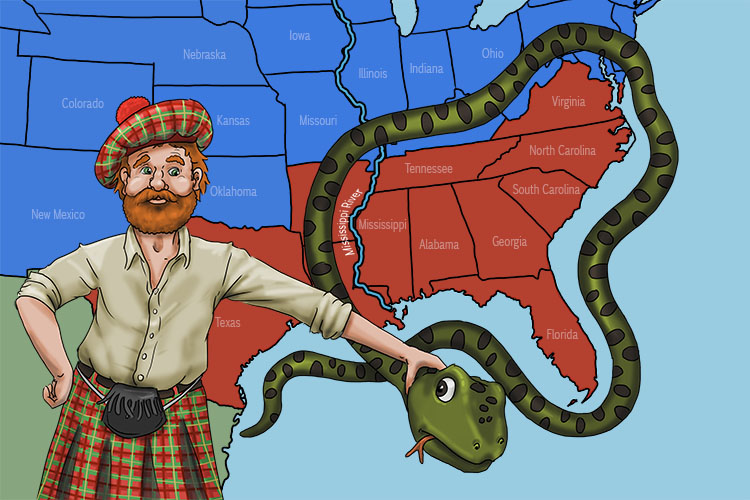Anaconda Plan – Union Army strategy by General Winfield Scott to block ports and advance down the Mississippi River to cut the South in two, suffocating the victim like an anaconda snake
(Pronounced an-uh-con-dah)

The anaconda snake (Anaconda Plan) was let loose around the ports and came down the Mississippi River. To ensure the snake stayed and the Union were the winners, a Scottish man (Winfield Scott) had hold of its head.
NOTE:
Winfield Scott wasn't really Scottish – this is just to help you remember his name.
The Anaconda Plan was the name given to a Union (Northern states) strategy to beat the Confederates (Southern states) at the start of the American Civil War.
The plan was to blockade the major Southern states seaports and for troops to advance down the Mississippi River, cutting the South in two. The strategy was described as being like an anaconda snake suffocating its victim – an image that caught on and gave the plan its name.
The strategy was proposed by the Union General-in-Chief Winfield Scott, who was known as "Old Fuss and Feathers" because of his insistence on correct military etiquette.
There were clear problems with the plan. For instance, no warships of the sort needed for the Mississippi campaign existed at the time.
Also, in the first few months of the war, the US navy was too small to enforce the blockade of Southern ports. Scott's plan had many critics and his opponents demanded an overland campaign directed mainly at the Confederate capital, Richmond, Virginia.
Of course, the American Civil War did not turn out to be the brief affair that Scott's critics had imagined. During the four years of the war, the U.S. Navy did enforce a blockade that weakened the South, although its actual effect on the war effort is still disputed by some.
The Confederacy was split in two by Union action based on the Mississippi and there is now a general view that this action was at least as important to the outcome of the war as the land battles that took place in other areas.
On this basis, it is argued the reasons behind the Northern victory turned out to be very similar to what Scott had envisaged at the start of the war. Some historians credit the Anaconda Plan with having guided President Abraham Lincoln's strategy throughout the conflict.
Interesting fact: The blockade of the Southern ports dramatically reduced trade for the Confederacy, which became financially strained just a year or so into the war. As its economy failed, citizens began to lose confidence in the Confederate Government.




